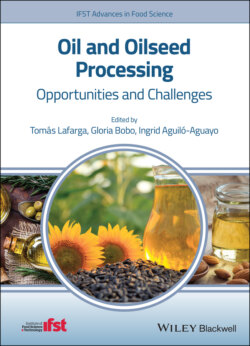Читать книгу Oil and Oilseed Processing - Ingrid Aguilo-Aguayo - Страница 13
1.1 Introduction
ОглавлениеLipids, which are together with proteins and carbohydrates the main constituents of plant and animal cells, can be broadly defined as substances such as fats, oils, or waxes that dissolve in organic solvents but not in water. Lipids, oil‐bearing nuts, and animal fats have been used by man for centuries. These were used for lighting, as cosmetics, applied to weapons or other utensils, and as foods, mainly as sources of energy or as medicines. Nowadays, the use of oils has expanded to several food applications which include cooking, frying, baking shortenings, salad dressing, and flavor carriers, among others. Each of these applications requires oils with specific physical and chemical properties (Gupta 2017). These properties will therefore determine the quality of the vegetable oil, which starts with high quality oilseeds or oil‐bearing nuts or fruits. Several factors which include maturity of the oilseed, climatic conditions, harvest conditions, handling of the harvested raw material, and storage can significantly affect the quality of the end product.
Broadly, oil extraction from seeds or beans is achieved by pressing and/or extraction using an organic solvent, generally hexane. Mechanical and thermal pre‐treatments can also be used to improve extraction yields (Savoire et al. 2013). Other oils such as avocado, palm, or olive oil are obtained after pressing of the whole fruit. Although some oils such as olive oil are used without further treatment than filtering, most of the currently commercialized edible oils are refined in some measure prior to commercialization (Gunstone 2011b). The term refining refers to the removal of several major and minor impurities and its main goal is to produce high quality oils with optimal properties to satisfy the different oil applications.
Oil production from oilseeds has been steadily increasing by an average of 12.3% annually over the last three decades: for the main oils – palm (palm kernel plus palm oil), rapeseed, soybean, and sunflower seed oil – there is a production increase of 231.1%, from 45.73 Mt in 1990 to 151.42 Mt in 2017 (UN 2019). Despite recent advances in oil extraction techniques, this impressive increase in oil production could not have been achieved without an increase in the quantity of seeds harvested. Indeed, during the same time period, the production of palm fruits, rapeseeds, soybean, and sunflower seeds followed the same trend from 159.29 Mt in 1990 to 794.31 Mt in 2017, representing an 17.7% annual increase (UN 2019).
The aim of the current chapter is to give an overview of the production of the most relevant vegetable oils and oilseeds, focusing on soybeans, rapeseeds, sunflower seeds, palm fruits, and the oils derived thereof. This chapter will also discuss the production quantities and trade of other common oilseeds such as groundnuts, maize, or sesame seeds as well as novel sources for oil production that are expected to soon gain an increased industrial relevance.
